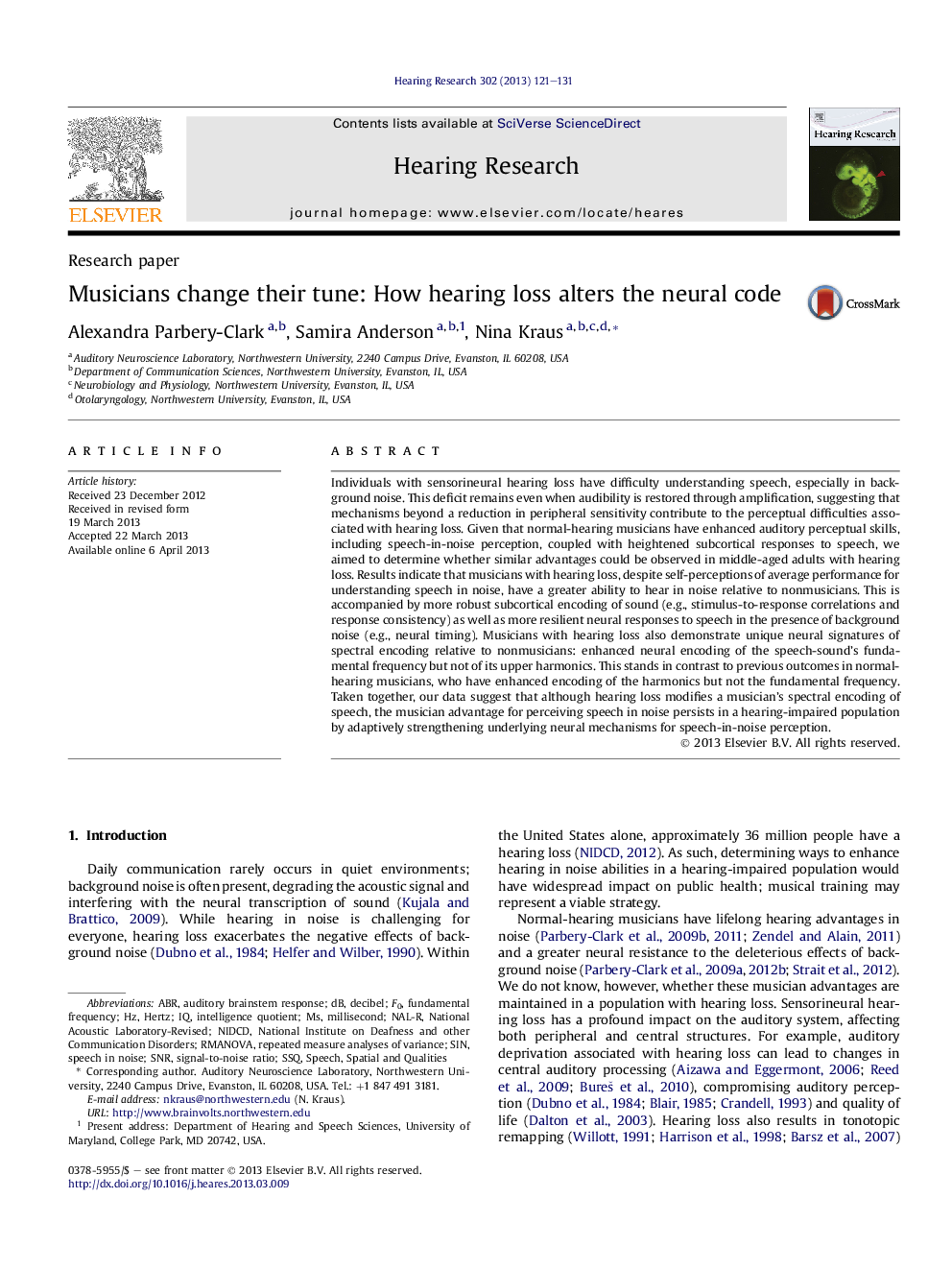| کد مقاله | کد نشریه | سال انتشار | مقاله انگلیسی | نسخه تمام متن |
|---|---|---|---|---|
| 6287549 | 1615598 | 2013 | 11 صفحه PDF | دانلود رایگان |
عنوان انگلیسی مقاله ISI
Musicians change their tune: How hearing loss alters the neural code
ترجمه فارسی عنوان
نوازندگان آهنگ خود را تغییر می دهند: چگونه میزان شنوایی تغییر کد عصبی
دانلود مقاله + سفارش ترجمه
دانلود مقاله ISI انگلیسی
رایگان برای ایرانیان
کلمات کلیدی
ترجمه چکیده
افراد مبتلا به کم شنوایی حس گرایانه دشوار درک گفتار، به ویژه در سر و صدای پس زمینه. این کسری باقی می ماند حتی زمانی که صدا از طریق تقویت دوباره بازسازی می شود، پیشنهاد می کند که مکانیزم فراتر از کاهش حساسیت محیطی به مشکلات ادراکی مرتبط با کاهش شنوایی کمک می کند. با توجه به اینکه نوازندگان عادی شنوایی مهارت های ادراکی شنیداری را افزایش داده اند، از جمله درک ادراک گفتار در نوک انگشتان، همراه با پاسخ های غلطکی به گفتار، ما با هدف تعیین اینکه آیا می توان از مزایای مشابه در بزرگسالان میانسال با کاهش شنوایی مشاهده کرد. نتایج نشان می دهد که نوازندگان با افت شنوایی، به رغم ادراکات خود از عملکرد متوسط برای درک گفتار در نویز، توانایی بیشتری در شنیدن نسبت به غیرمسلمانان دارند. این امر با رمزگذاری صدای زیرکورتری قویتر (مثلا همبستگیهای تحریک به پاسخ و هماهنگی پاسخ) و همچنین پاسخهای عصبی انعطافپذیر بیشتر در حضور سر و صدای پسزمینه (به عنوان مثال، زمان عصبی) همراه است. موسیقیدانان با افت شنوایی نیز نشانه های عصبی منحصر به فرد از رمزگذاری طیفی نسبت به غیرمسلمانان را نشان می دهند: رمزگذاری عصبی فرکانس اساسی صدا، اما نه از هماهنگی بالایی آن. این در مقایسه با نتایج قبلی در نوازندگان معمولی شنوایی است که رمزگذاری هارمونیک ها را افزایش داده اند اما نه فرکانس اساسی. با توجه به داده های ما نشان می دهد که هرچند کمبود شنوایی یک رمز نگاری طیفی نوازنده را بیان می کند، مزیت نوازنده برای درک گفتار در نویز در یک گروه اختلال شنوایی با تقویت سازگاری سازه های زیربنایی عصبی برای ادراک گفتار در نویز ادامه می یابد.
موضوعات مرتبط
علوم زیستی و بیوفناوری
علم عصب شناسی
سیستم های حسی
چکیده انگلیسی
Individuals with sensorineural hearing loss have difficulty understanding speech, especially in background noise. This deficit remains even when audibility is restored through amplification, suggesting that mechanisms beyond a reduction in peripheral sensitivity contribute to the perceptual difficulties associated with hearing loss. Given that normal-hearing musicians have enhanced auditory perceptual skills, including speech-in-noise perception, coupled with heightened subcortical responses to speech, we aimed to determine whether similar advantages could be observed in middle-aged adults with hearing loss. Results indicate that musicians with hearing loss, despite self-perceptions of average performance for understanding speech in noise, have a greater ability to hear in noise relative to nonmusicians. This is accompanied by more robust subcortical encoding of sound (e.g., stimulus-to-response correlations and response consistency) as well as more resilient neural responses to speech in the presence of background noise (e.g., neural timing). Musicians with hearing loss also demonstrate unique neural signatures of spectral encoding relative to nonmusicians: enhanced neural encoding of the speech-sound's fundamental frequency but not of its upper harmonics. This stands in contrast to previous outcomes in normal-hearing musicians, who have enhanced encoding of the harmonics but not the fundamental frequency. Taken together, our data suggest that although hearing loss modifies a musician's spectral encoding of speech, the musician advantage for perceiving speech in noise persists in a hearing-impaired population by adaptively strengthening underlying neural mechanisms for speech-in-noise perception.
ناشر
Database: Elsevier - ScienceDirect (ساینس دایرکت)
Journal: Hearing Research - Volume 302, August 2013, Pages 121-131
Journal: Hearing Research - Volume 302, August 2013, Pages 121-131
نویسندگان
Alexandra Parbery-Clark, Samira Anderson, Nina Kraus,
